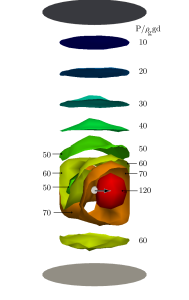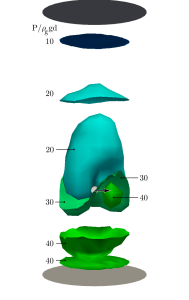When an object moves through a granular medium, it experiences forces. Drag forces are against the object motion, whereas lift force act perpendicular to the object direction of motion. The following movie shows how lift forces caused by a medium of glass spheres makes a glass bead move upward and reach the surface after having been plunged down.
In a granular material, it is harder to move an object the deeper it is, because the drag force increases with the pressure. However, this is not always true: some particular trajectory of the object can screen the weight of the grains that are above, leading to a drag force much lower than expected. This is what is shown in the following graph (DEM simulations), where a cylinder rotates through a granular medium. The pressure field is completely different before rotating and after several rotations.
| First rotation | Steady state |
 |  |
frame moving with the rotating cylinder during the first half-turn.
(Right) Same plot in the steady state. Only the central region is shown,
the bottom and top disks indicating the actual size of the container.
More:
About the lift: F. Guillard, Y. Forterre, O. Pouliquen. Lift forces in granular media.Physics of Fluids 26 043301. (2014)
About the drag saturation: F. Guillard, Y. Forterre, O. Pouliquen. Depth independent drag force induced by stirring in granular media Physical Review Letters 110 138303 (2013)
About the structuration: F. Guillard, Y. Forterre, O. Pouliquen. Origin of a depth-independent drag force induced by stirring in granular media. Physical Review E. 91 022201 (2015)